History of Electricity
History is a great way to learn about electricity because we can retrace the steps humans have taken along the way. We have gone from observing, to theorizing and experimenting, and finally to harnessing the power of electricity around the world. In retracing the history of electricity, we gain insights into its nature and how it has influenced humans from our earliest days.
From Weapon Of Zeus to Cell Phones
Electricity has been explored and referenced by many cultures throughout history. The history of electricity as a field of study began with observations of electricity from the ancient Egyptian and Greek cultures. Ancient Greek writings show sophisticated observations about electricity, like static electricity from rubbing amber.
However, it wasn’t until the 17th century that scientists began seriously studying electricity. Development then proceeded quickly; by the end of the 19th century, research and development in the field was an exciting and lucrative field.

In Giulio Romano’s Fall of the Giants, Zeus descends from his heavenly throne to defeat the rebellious Giants using lightning bolts.
Within one century of the first electric power systems, the vast majority of the world economy had been transformed by electric power and computing into an information-based system.

Alessandro Volta showing his Voltaic pile, the world’s first battery, to Napoleon Bonaparte.
Electricity and the Ancients
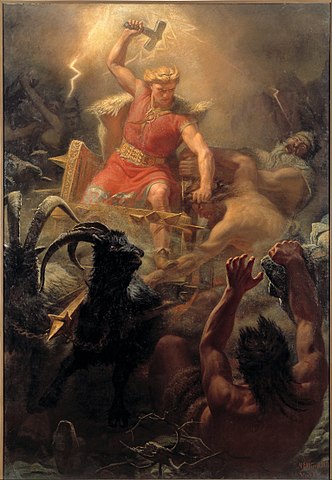
Thor’s Fight with the Giants by Mårten Eskil Winge.
Virtually every culture has been fascinated by electric phenomena. Lightning was perhaps the first light show or firework display, and its power and mystery invoked the spiritual element in virtually every society. The Greek god Zeus wielded lightning as the most feared and powerful weapon in the heavens and earth. Similarly, the Germanic god Thor was associated with lightning and was believed to be its’ originator.
Lightning holds a prominent place in Hindu mythology, wielded by Indra, the king of heaven.
Thunder and lightning were also consistent reminders of God’s power in the Bible, playing a key role in the thematic culmination of the exodus story, on Mt. Sinai.
So powerful was lightning, the natural spectacle of electricity, that our ancestors had no doubt it was of supernatural origin. Whoever could control it would therefore wield an almost unimaginable power.
Some of the very first writings in history feature observations of electrical phenomena. Electric shocks from fish and rays were observed and prescribed in ancient Greece to treat headaches. Around 600 BC, Thales of Miletus made observations about static electricity generated by rubbing amber. It had been discovered that a rubbed piece of amber would attract particles like dust and two rubbed pieces of amber would repel each other. Thales incorrectly ascribed the attraction of dust to the amber as magnetism, which he had also researched by studying magnetic lodestones.

The word ‘electricity’ comes from the Greek word for amber, elektron.
Lodestones are magnetic pieces of the mineral magnetite. Modern scientists believe that they are probably magnetized by the powerful magnetic fields generated during a lightning strike. It seems that even in ancient times, humans seemed to glimpse the realization that electricity and magnetism might be related to each other.
17th Century: The Science of Electricus
For many centuries, electricity remained in the realm of the supernatural.
It wasn’t until the 17th century that explorations of electromagnetic phenomena began in earnest. The English scientist William Gilbert was able to distinguish between static electricity and the lodestone, or magnetic, effect. While describing static electricity, he coined the term electricus, which means ‘like amber’, based on the Greek word for amber, elektron.
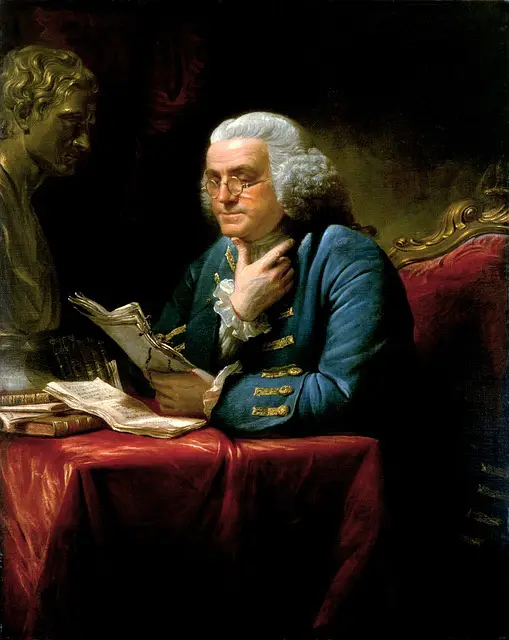
Portrait of Benjamin Franklin by David Martin.
For the next century and a half many scientists helped to further the study of electricity. Building on these works, Benjamin Franklin, one of the Founding Fathers of the US, dedicated himself to the topic. He sold his possessions to finance his studies.
Franklin supposedly proved the electric nature of lightning by tying a key to a kite and observing sparks jumping from the key to his own hand during a storm. In actuality, he was able to demonstrate that the storm generated large amounts of electrical energy. Had his kite actually been struck by lightning, he would have very likely been electrocuted.
But he made his point. Franklin used the kite to store electrical energy in a Leyden Jar, an early capacitor that uses the glass of a jar to store electric charge.
A Leyden jar is a glass jar that is lined on the inside and outside with metal foil. The inner foil is connected to a chain and rod that protrudes through the mouth of the jar. When the rod and outer foil are connected to a voltage source, the glass accumulates electric charge, thus acting as a capacitor.
Leyden jars were in common usage in electrical experiments at the time.
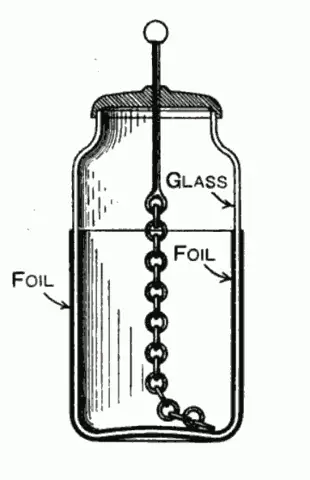
Construction of a Leyden jar.
By using Leyden Jars charged with the storm’s energy, Benjamin Franklin was able to definitively prove that the energy captured from the thunderstorm was identical to electrical energy created by other means, such as rubbing amber.
Thus Franklin accomplished an incredible and historical task. Not only was he able to explain the nature of lightning, he was even able to ‘collect’ it and wield it during experimentation. Using this knowledge, he later invented the lightning rod, the first lightning protection system.
Early 19th Century: Volta and the First Battery
In 1800, Alessandro Volta (namesake of the Volt) published his research on the Voltaic pile, the world’s first battery. While it was similar to the Leyden Jar, it had some important differences. The Leyden Jar stored electrical energy directly in an electric field and discharged immediately when connected to a circuit.
Instead, the Voltaic pile used electrochemistry to chemically produce a source and a sink for electrons in a circuit.
Volta’s idea came from an experiment by Luigi Galvani, who discovered that a frog’s leg could be made to twitch by connecting it to two different metals.
Volta decided to expand on Galvani’s work by stacking copper and zinc disks in an alternating fashion. He separated each disk from it’s neighbors with cardboard or cloth soaked in brine (high concentration salt water).

Replica of the first Voltaic pile, containing 46 copper-zinc cells.
Volta found that if he connected the top of the stack to the bottom with a conducting wire, electric current would flow through the wire. He called this invention a Voltaic pile. Since the Voltaic pile uses an electrochemical reaction to produce electricity, it could would more slowly than a Leyden Jar. By stacking more layers of metal, the capacity of the pile could be increased, allowing it to store more energy than a Leyden Jar as well.
The Leyden Jar and Voltaic pile might sound like museum artifacts but we still use versions of them. We now call them capacitors and batteries, and they are some of the most commonly used devices in modern electronics. We’ll be discussing these devices in Module 3 in this course.
19th Century: Faraday, Maxwell, and The War of Currents
Advances in research and development became frequent as the 19th century progressed. Scientists and the public were fascinated with the potential of harnessing this great phenomenon. It became easier to find investors to fund experimentation and invention.
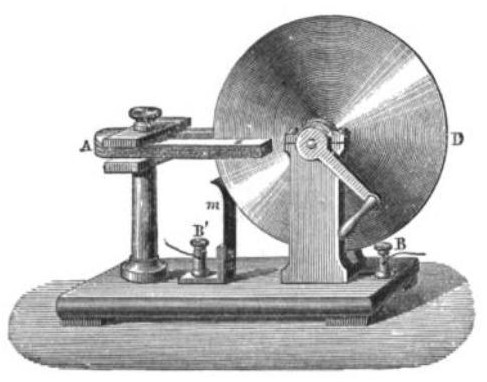
The world’s first electric generator, the Faraday disk.
In 1821, Michael Faraday invented the electric motor, the first device that could convert electrical energy into mechanical energy.
A decade later, in 1831, Faraday invented the first electric generator, called a Faraday disk. A Faraday disk is made by mounting a copper disk onto supports and placing a horseshoe shaped magnet on one end of the disk. A wire is then connected to the center of the disk and another is attached to a spring that rubs against the edge of the disk. When the disk is rotated by hand, an electric current is generated between the two wires.
Meanwhile, in 1827 Georg Ohm published a book that included what is now one of the most important equations in physics, and probably the most important equation in electronics: Ohm’s Law. Ohm’s Law accurately describes the relationship between voltage, current, and resistance in a circuit. It took almost three decades before Ohm’s Law was widely accepted by the scientific community.
In 1861, James Clerk Maxwell mathematically proved the interwoven nature of electricity, magnetism, and light.
The 1880s and 1890s saw the ‘War of the Currents’, a battle between DC power supported by Thomas Edison and AC power supported by George Westinghouse, using Nikola Tesla’s AC induction motor design. The invention of the transistor allowed AC to be transmitted over long distances with minimal loss, making AC power much more practical than DC power.
20th Century: The Information Age
While first mechanical computers had been in development for centuries, the early 20th century saw the first computers that relied on electricity. In the 1930’s, electromechanical computers based on relays using binary logic to perform advanced computations.
Relays could be turned ‘on’ and ‘off’ via an external signal, which became the basis of the binary systems still used today.
Vacuum tubes increased the reliability and power of large computers, which saw important uses during WWII.
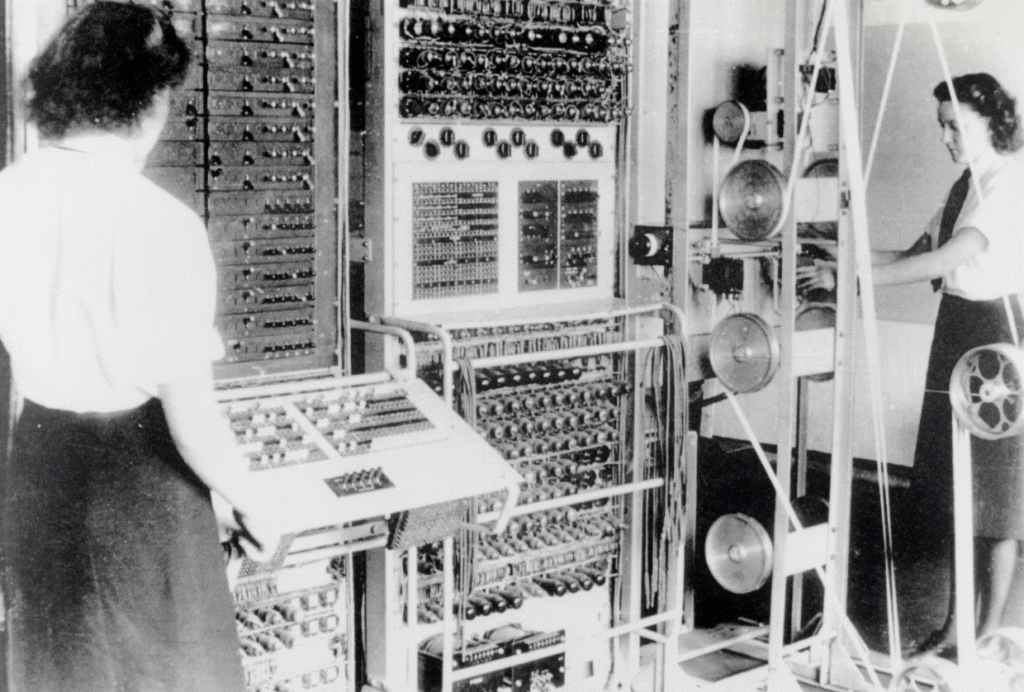
Colossus was a vacuum tube based computer used to code-break German ciphers during WWII.
In 1947 the first transistor was created at Bell Labs, heralding the era of the semiconductor, enabled by new technologies allowing miniaturization by creating complete circuits directly on a semiconductor substrate. These new, individually packaged circuits were known as integrated circuits.
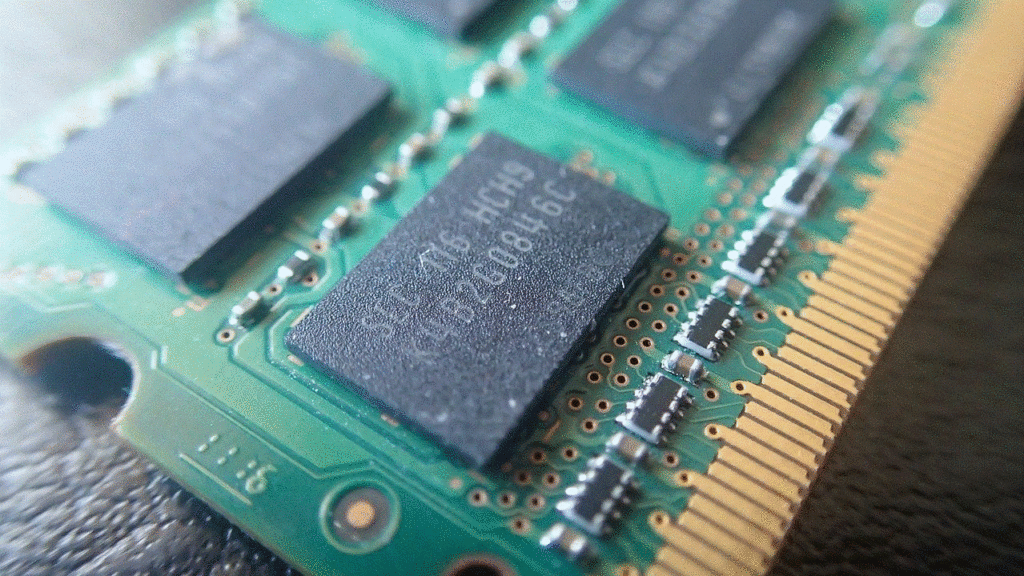
Modern computer circuits like this RAM chip rely on semiconductor based integrated circuits. They hold millions or billions of transistors.
The next several decades saw increasingly rapid progress in semiconductor and circuit design. Computers that once required a huge amount of space could now be compact enough for the average home. Supercomputers became more powerful, enabling new fields of research in science and technology. Transistors and other components began approaching atomic sizes, dictated by quantum mechanics. This progress was predicted, and in part enabled by what came to be known as Moore’s Law, an observation that the number of components in integrated circuits would double every two years.
The progress of the 20th century would not have been possible without myriad fields of study enabling further development. The subjects of electrodynamics, electrical engineering, mechanical engineering, quantum mechanics, chemistry, materials science, and even thermodynamics all informed new technological developments.
It is a true miracle of human cooperation that you can read this from your home or possibly a device smaller than your own hand.
Let’s continue with an exploration of how our electricity is generated and transmitted, in:
Lesson 3: Electrical Power Generation